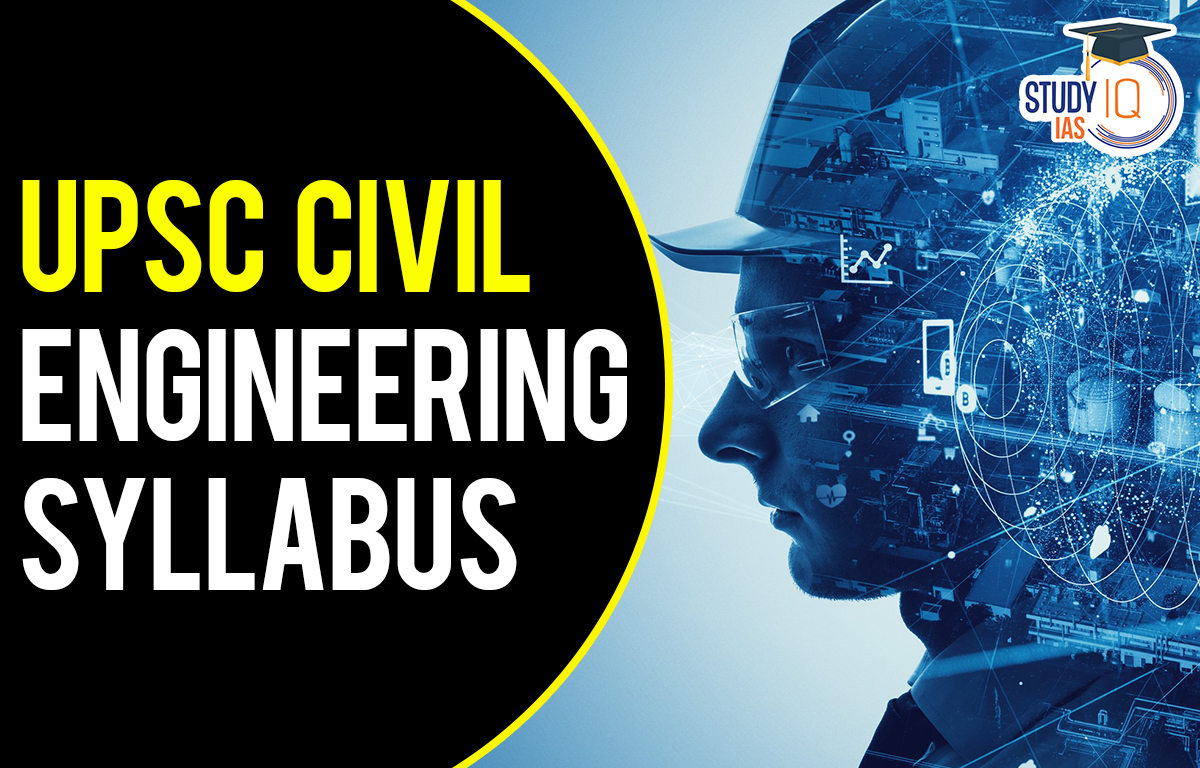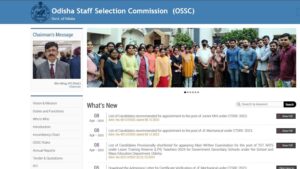Table of Contents
There are 48 optional subjects on the UPSC list, including Civil Engineering. The UPSC Civil Engineering Syllabus emphasises candidates’ understanding of fundamental concepts and application of knowledge to problems of sustainable development. Candidates must go through the UPSC Civil Engineering Syllabus PDF before preparing for the UPSC exam.
Candidates who choose Civil Engineering as an optional subject in the IAS Exam will find the detailed UPSC Civil Engineering optional syllabus as well as the UPSC Civil Engineering Syllabus PDF in the article below.
| UPSC Civil Engineering Syllabus | Topics |
| UPSC Civil Engineering Optional Syllabus Paper 1 |
|
| UPSC Civil Engineering Optional Syllabus Paper 2 |
|
UPSC Civil Engineering Optional Exam Pattern
| Mains Papers | Subject | Marks |
| Paper VI | UPSC Civil Engineering Optional Paper 1 | 250 |
| Paper VII | UPSC Civil Engineering Optional Paper 2 | 250 |
| Total | 500 | |
| Time duration | 3 hours (180 minutes) | |
UPSC Civil Engineering Optional Syllabus PDF
Civil Engineering Syllabus For UPSC
UPSC Mains Civil Engineering Optional subject has two papers (Paper I and Paper II). Each paper carries 250 marks out of marks.
Civil Engineering Optional Paper I Syllabus:
Know about the UPSC Civil Engineering Optional Syllabus for Paper 1 below:
1.Engineering Mechanics, Strength of Materials and Structural Analysis
| Engineering Mechanics, Strength of Materials and Structural Analysis | |
| Engineering Mechanics: |
|
| Strength of Materials: |
|
| Structural Analysis: |
|
- Design of Structures: Steel, Concrete and Masonry Structures:
|
Design of Structures: Steel, Concrete and Masonry Structures: |
|
| Structural Steel Design: Structural Steel: |
|
| Design of Concrete and Masonry Structures: |
|
- Fluid Mechanics, Open Channel Flow and Hydraulic Machines:
| Fluid Mechanics, Open Channel Flow and Hydraulic Machines: |
|
| Fluid Mechanics: |
|
| Dimensional Analysis and Similitude: |
|
| Laminar Flow: |
|
| Boundary layer: |
|
| Open channel flow: |
|
| Hydraulic Machines and Hydropower |
|
Geotechnical Engineering:
| Geotechnical Engineering: | |
| Geotechnical Engineering: | Soil Type and structure – gradation and particle size distribution – consistency limits.Water in soil – capillary and structural – effective stress and pore water pressure – permeability concept – field and laboratory determination of permeability – Seepage pressure – quick sand conditions – Shear strength determination – Mohr Coulomb concept. Compaction of soil – Laboratory and field tests. Compressibility and consolidation concept – consolidation theory – consolidation settlement analysis. Earth pressure theory and analysis for retaining walls, Application for sheet piles and Braced excavation. Bearing capacity of soil – approaches for analysis – Field tests – settlement analysis – stability of slope of earth walk. Subsurface exploration of soils – methods Foundation – Type and selection criteria for foundation of structures – Design criteria for foundation – Analysis of distribution of stress for footings and pile – pile group action-pile load test. Ground improvement techniques. |
Civil Engineering Optional Paper II Syllabus:
- Construction Technology, Equipment, Planning and Management:
| Construction Technology, Equipment, Planning and Management: |
|
| Construction Technology: | Engineering Materials: Physical properties of construction materials with respect to their use in construction – Stones, Bricks and Tiles; Lime, Cement, different types of Mortars and Concrete. Specific use of ferro cement, fibre reinforced C.C, High strength concrete. Timber, properties and defects – common preservation treatments. Use and selection of materials for specific use like Low Cost Housing, Mass Housing, High Rise Buildings. |
| Construction: | Masonry principles using Brick, stone, Blocks – construction detailing and strength characteristics. Types of plastering, pointing, flooring, roofing and construction features. Common repairs in buildings. Principles of functional planning of building for residents and specific use – Building code provisions. Basic principles of detailed and approximate estimating – specification writing and rate analysis – principles of valuation of real property. Machinery for earthwork, concreting and their specific uses – Factors affecting selection of equipments – operating cost of Equipments. |
| Construction Planning and Management: | Construction activity – schedules- organization for construction industry – Quality assurance principles. Use of Basic principles of network – analysis in form of CPM and PERT – their use in construction monitoring, Cost optimization and resource allocation. Basic principles of Economic analysis and methods. Project profitability – Basic principles of Boot approach to financial planning – simple toll fixation criterions. |
- Surveying and Transportation Engineering :
| Surveying and Transportation Engineering : |
|
| Surveying: | Common methods and instruments for distance and angle measurement for CE work – their use in plane table, traverse survey, leveling work, triangulation, contouring and topographical map. Basic principles of photogrammetry and remote sensing. |
| Railway Engineering: | Permanent way – components, types and their functions – Functions and Design constituents of turn and crossings – Necessity of geometric design of track – Design of station and yards. |
| Highway Engineering: | Principles of Highway alignments – classification and geometrical design elements and standards for Roads. Pavement structure for flexible and rigid pavements – Design principles and methodology of pavements. Typical construction methods and standards of materials for stabilized soil, WBM, Bituminous works and CC roads. Surface and sub-surface drainage arrangements for roads – culvert structures. Pavement distresses and strengthening by overlays. Traffic surveys and their applications in traffic planning – Typical design features for channelized, intersection, rotary etc – signal designs – standard Traffic signs and markings. |
- Hydrology, Water Resources and Engineering:
| Hydrology, Water Resources and Engineering: |
|
| Hydrology: | Hydrological cycle, precipitation, evaporation, transpiration, infiltration, overland flow, hydrograph, flood frequency analysis, flood routing through a reservoir, channel flow routing-Muskingam method. |
| Ground water flow: | Specific yield, storage coefficient, coefficient of permeability, confined and unconfined equifers, aquifers, aquitards, radial flow into a well under confined and unconfined conditions. |
| Water Resources Engineering: | Ground and surface water resource, single and multipurpose projects, storage capacity of reservoirs, reservoir losses, reservoir sedimentation. |
| Irrigation Engineering: | (i) Water requirements of crops: consumptive use, duty and delta, irrigation methods and their efficiencies.
(ii) Canals: Distribution systems for canal irrigation, canal capacity, canal losses, alignment of main and distributory canals, most efficient section, lined canals, their design, regime theory, critical shear stress, bed load. (iii) Water logging: causes and control, salinity. (iv) Canal structures: Design of, head regulators, canal falls, aqueducts, metering flumes and canal outlets. (v) Diversion headwork: Principles and design of weirs of permeable and impermeable foundation, Khosla’s theory, energy dissipation. (vi) Storage works: Types of dams, design, principles of rigid gravity, stability analysis. (vii) Spillways: Spillway types, energy dissipation. (viii) River training: Objectives of river training, methods of river training. |
- Environmental Engineering:
| Environmental Engineering: |
|
| Water Supply: | Predicting demand for water, impurities of water and their significance, physical, chemical and bacteriological analysis, waterborne diseases, standards for potable water. |
| Intake of water: | Water treatment: principles of coagulation, flocculation and sedimentation; slow-; rapid-, pressure-, filters; chlorination, softening, removal of taste, odour and salinity. |
| Sewerage systems | Domestic and industrial wastes, storm sewage-separate and combined systems, flow through sewers, design of sewers. |
| Sewage characterization: | BOD, COD, solids, dissolved oxygen, nitrogen and TOC. Standards of disposal in normal watercourse and on land. |
| Sewage treatment: | Working principles, units, chambers, sedimentation tanks, trickling filters, oxidation ponds, activated sludge process, septic tank, disposal of sludge, recycling of wastewater. |
| Solid waste: | Collection and disposal in rural and urban contexts, management of long-term ill effects. |
- Environmental pollution: Sustainable development. Radioactive wastes and disposal. Environmental impact assessment for thermal power plants, mines, river valley projects. Air pollution. Pollution control acts.


 Daily Quiz 18 April 2025
Daily Quiz 18 April 2025
 OSSC CGL Syllabus 2025 and Exam Pattern ...
OSSC CGL Syllabus 2025 and Exam Pattern ...
 AI and its Regulation in India, Limitati...
AI and its Regulation in India, Limitati...





















